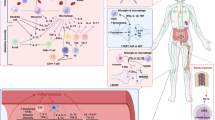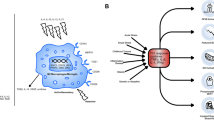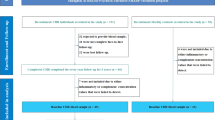Abstract
Serotonin (5-HT) is a neurotransmitter and an immune modulator. In vitro, antidepressants with a serotonergic mode of action have, at concentrations within the therapeutical range, negative immunoregulatory effects, i.e., they increase the production rate of interleukin-10 (IL-10), a negative immunoregulatory cytokine. We have hypothesized that part of these effects may be explained by the serotonergic activities of antidepressants on immunocytes. This study was carried out to examine the effects of 5-HT, p-chlorophenylalanine (PCPA), a 5-HT depleting agent, flesinoxan (a 5-HT1A agonist), m-chlorophenylpiperazine (mCPP; a 5-HT2A/2C agonist), and ritanserin (a 5-HT2A/2C antagonist) on the production rate of interferon-γ (IFNγ), a proinflammatory cytokine, and IL-10 by whole blood stimulated with polyclonal activators. The IFNγ/IL-10 production ratio was computed, since this ratio reflects the pro- versus anti-inflammatory capacity of cultured whole blood. We found that: 1) 5-HT, 150 ng/mL, 1.5 μg/mL, and 15 μg/mL significantly decreased the IFNγ/IL-10 ratio; 2) PCPA (5 μM) significantly suppressed the production of IFNγ and IL-10; 3) flesinoxan (15 ng/mL; 1.5 μg/mL) had no significant effects on the production of the above cytokines; and 4) mCPP (2.7 μg/mL) and ritanserin (5.0 μg/mL) suppressed the IFNγ/IL-10 ratio. It is concluded that intracellular 5-HT may be necessary for an optimal synthesis of IFNγ and IL-10, and that extracellular 5-HT concentrations at or above serum values may suppress the production of the proinflammatory cytokine IFNγ. The negative immunoregulatory effects of antidepressive drugs are probably not related to their serotonergic activities.
Similar content being viewed by others
Log in or create a free account to read this content
Gain free access to this article, as well as selected content from this journal and more on nature.com
or
References
Ameisen J-C, Meade R, Askenase PW . (1989): A new interpretation of the involvement of serotonin in delayed-type hypersensitivity: Serotonin-2 receptor antagonists inhibit contact sensitivity by an effect on T cells. J Immunol 142: 3171–3179
American Psychiatric Association. (1994): Diagnostic and Statistical Manual of Mental Disorders. 4th Ed. Washington DC, American Psychiatric Association
Arzt E, Costas M, Finkielman S, Nahmod VE . (1991): Serotonin inhibition of tumor necrosis factor-alpha synthesis by human monocytes. Life Sci 48: 2557–2562
Aune TM, McGrath KM, Sarry T, Bombara MP, Kelley KA . (1993): Expression of 5HT1a receptors on activated human T cells. J Immunol 151: 1175–1183
Aune MT, Golden HW, McGrath KM . (1994): Inhibitors of serotonin synthesis and antagonists of serotonin 1A receptors inhibit T lymphocyte function in vitro and cell-mediated immunity in vivo. J Immunol 153: 489–498
Baumann MH, Mash DC, Staley JK . (1995): The serotonin agonist m-chlorophenylpiperazine (mCPP) binds to serotonin transporter sites in human brain. Clin Neurosci Neuropathol 6: 2150–2152
Benbernou N, Esnault S, Shin HCK, Fekkar H, Guenounou M . (1997): Differential regulation of IFN-γ, IL-10 and inducible nitric oxide synthase in human T cells by cyclic AMP-dependent signal transduction pathway. Immunology 91: 361–368
Bluthé RM, Crestani F, Kelley KW, Dantzer R . (1992): Mechanisms of the behavioral effects of interleukin 1. Ann NY Acad Sci 650: 268–275
Bonnet M, Lespinats G, Burtin C . (1984): Histamine and serotonin suppression of lymphocyte response to phytohemagglutinin and antigen. Cell Immunol 83: 280–291
Boranic M, Pericic D, Poljak-Blazi M, Sverko V, Marotti T . (1987): Suppression of immune response in rats by stress and drugs interfering with metabolism of serotonin. Ann NY Acad Sci 496: 485–491
Candore G, Di Lorenzo G, Melluso M, Cigna D, Colucci AT, Modica MA, Caruso C . (1993): Gamma-Interferon, interleukin-4 and interleukin-6 in vitro production in old subjects. Autoimmunity 16: 275–280
Cavaillon J-M . (1996): Les Cytokines. Paris, Masson
Cohen RAJ, Zitnay KM, Weisbrod RM . (1985): Platelet-induced neurogenic coronary contraction due to accumulation of the false neurotransmitter, 5-hydroxytryptamine. Clin Invest 75: 286–292
Connor TJ, Leonard BE . (1998): Depression, stress and immunological activation: The role of cytokines in depressive disorders. Life Sci 62: 583–606
De Groote D, Zangerle PF, Gevaert Y, Fassotte MF, Beguin Y, Noizat-Pirenne F, Pirenne J, Gathy R, Lopez M, Dehart I, Igot D, Baudrihaye M, Delacroix D, Franchimont P . (1992): Direct stimulation of cytokines (IL-1β, TNF-α, IL-6, IL-2, IFN-γ and GM-CSF) in whole blood. I. Comparison with isolated PBMC stimulation. Cytokine 4: 239–248
De Groote D, Gevaert Y, Lopez M, Gathy R, Fauchet F, Dehart I, Jadoul M, Radoux D, Franchimont P . (1993): Novel method for the measurement of cytokine production by one-stage procedure. J Immunol Meth 9: 259–267
Devoino LV, Korovina LS, Ilyutchenok RY . (1968): Influence of some drugs on the immune response. I. The effect of 5-hydroxytryptophan, iproniazid and reserpine on primary and secondary immune responses Eur J Pharmacol 4: 441–448
Devoino LV, Morozova NB . (1988): Serotoninergic system in neuroimmunomodulation: Mechanism of inhibition. In Novera HS (ed), Neuroimmunomodulation, Proceedings of the First International Workshop, Bethesda, 27–30 November 1984. New York, Gordon and Breach Sciences Publishers, pp 119–123
Eliseeva LS, Stefanovich LE . (1982): Specific binding of serotonin by blood leukocytes and peritoneal cells in the mouse. Biokhimiia 47: 810–813
Essmann WB . (1978): Serotonin distribution in tissue and fluids. In WB Essmann (ed), Serotonin in Health and Disease, Vol. 1. New York, Spectrum, pp 85–91
Felten DL, Cohen N, Ader R, Felten SY, Carlson SL, Roszman TL . (1991): Psychoneuroimmunology. In Ader R, Felten DL, Cohen N (eds), Psychoneuroimmunology. San Diego, Academic Press, pp 1–26
Finocchiaro LME, Arzt ES, Fernandez-Castelo S, Criscuolo M, Finkielman S, Nahmod VE . (1988): Serotonin and melatonin synthesis in peripheral blood mononuclear cells: Stimulation by interferon-g as part of an immunomodulatory pathway. J Interferon Res 8: 705–716
Gershon RK, Askenase PW, Gershon MD . (1975): Requirement for vasoactive amines for production of delayed-type hypersensitivity skin reactions. J Exp Med 142: 732–747
Hamik P, Peroutka S . (1989): mCPP interactions with neurotransmitter receptors in the human brain. Biol Psychiatry 25: 569–575
Hamilton M . (1960): A rating scale for depression. J Neurol Neurosurg Psychiatry 23: 56–61
Hellestrand K, Czerkinsky C, Ricksten A, Jansson B, Asea A, Kylefjord H, Hermodsson S . (1993): Role of serotonin in the regulation of interferon-gamma production by human natural killer cells. J Interferon Res 13: 33–38
Jackson JC, Cross RJ, Walker RF . (1985): Influence of serotonin on the immune response. J Immunol 54: 505–513
Jahnova E . (1994): The effect of risperidone and ritanserin on human IgG and IgM synthesis in vitro. Physiol Res 43: 27–31
Katsikis PD, Cohen SB, Londei M, Feldmann M . (1995): Are CD4+ Th1 cells pro-inflammatory or anti-inflammatory? The ratio of IL-10 to IFN-gamma or IL-2 determnines their function. Intl Immunol 7: 1287–1294
Kubera M, Maes M . (1999): Serotonin-immune interactions in major depression. In Patterson PH, Kordon C, Christen Y. Fondation IPSEN (eds), Neuroimmune Interactions in Neurologic and Psychiatric Disorders. New York, Springer Verlag, pp 79–88
Lin A, Song C, Kenis G, Bosmans E, De Jongh R, Scharpe S, Maes M : The in vitro immunosuppressive effects of moclobemide. J Affect Disord (in press).
Maes M . (1997): The immune pathophysiology of major depression. In Honig A, van Praag H (eds), Depression: Neurobiological, Psychopathological and Therapeutic Advances. Chichester, John Wiley, pp 197–215
Maes M, Meltzer HYM . (1995): The serotonin hypothesis of major depression. In Bloom F, Kupfer D (eds), Psychopharmacology: The Fourth Generation of Progress. New York, Raven Press, pp 933–944
Maes M, Smith R, Scharpe S . (1995): The monocyte-T-lymphocyte hypothesis of major depression. Psychoneuroendocrinology 20: 111–116
Maes M, Delanghe J, Ranjan R, Meltzer HY, Desnyder R, Cooreman W, Scharpe S . (1997): The acute phase protein response in schizophrenia, mania and major depression: Effects of psychotropic drugs. Psychiatry Res 66: 1–11
Maes M, Song C, Lin A, De Jongh R, Van Gastel A, Kenis G, Bosmans E, De Meester I, Benoy I, Neels H, Demedts P, Janca A, Scharpe S, Smith RS . (1998): The effects of psychological stress on humans: Increased production of pro-inflammatory cytokines and a Th1-like response in stress-induced anxiety. Cytokine 10: 313–318
Maes M, Song C, Lin A-H, Bonaccorso S, Kenis G, De Jongh R, Bosmans E, Scharpe S . (1999): Negative immunoregulatory effects of antidepressants: Inhibition of interferon-γ and stimulation of interleukin-10 secretion. Neuropsychopharmacology 20: 370–379
Markstein R, Matsumoto M, Kohler C, Togashi H, Yoshioka M, Hoyer D . (1999): Pharmacological characterization of 5-HT receptors positively coupled to adenyl cyclase in the rat hippocampus. Naunyn Schiedebergs Arch Pharmacol 359: 454–459
Mossner R, Lesch K-P . (1998): Role of serotonin in the immune system and in neuroimmune interactions. Brain Behav Immun 12: 249–271
Murray PJ, Wang L, Onufryk C, Tepper RI, Young RA . (1997): T cell-derived IL-10 antagonizes macrophage function in mycobacterial infections. J Immunol 158: 315–321
Nordlind K, Sundstrom E, Bondesson L . (1992): Inhibiting effect of serotonin antagonists on the proliferation of mercuric chloride stimulated human peripheral blood T lymphocytes. Intl Arch Allergy Immunol 87: 105–108
Platzer C, Meisel C, Vogt K, Platzer M, Volk HD . (1995): Up-regulation of monocytic IL-10 by tumor necrosis factor-alpha and cAMP elevating drugs. Intl Immunol 7: 517
Ptak W, Geba GP, Askenase PW . (1991): Initiation of delayed-type hypersensitivity by low doses of monoclonal IgE antibody. Mediation by serotonin and inhibition by histamine. J Immunol 146: 3929–3936
Roszman TL, Jackson JC, Cross RJ, Titus MJ, Markesbery WR, Brooks WH . (1985): Neuroanatomic and neurotransmitter influences on immune function. J Immunol 135: 769S–772S
Schoeffter P, Hoyer D . (1989): Interaction of arylpiperazines with 5-HT1A, 5-HT1B, 5-HT1C and 5-HT1D receptors: Do discriminatory 5-HT1B receptor ligands exist? Arch Pharmacol 339: 675–683
Seidel A, Arolt V, Hunstiger M, Rink L, Behnisch A, Kirchner H . (1995): Cytokine production and serum proteins in depression. Scand J Immunol 41: 534–538
Sluzewska A, Rybakowski JK, Laciak M, Mackiewicz A, Sobieska M, Wiktorowicz K . (1995): Interleukin-6 serum levels in depressed patients before and after treatment with fluoxetine. Ann Acad Sci 762: 474–476
Spitzer RL, Williams JBW, Gibbon M, First MB . (1990): Structured Clinical Interview According to DSM-III-R. New York, American Press
Sternberg EM, Wedner HJ, Leung MK, Parker CW . (1987): Effect of serotonin (5-HT) and other monoamines on murine macrophages: Modulation of interferon-gamma induced phagocytosis. J Immunol 138: 4360–4365
Xia Z, DePierre JW, Nassberger L . (1996): Tricyclic antidepressants inhibit IL-6, IL-1β and TNF-α release in human blood monocytes and IL-2 and interferon-γ in T cells. Immunopharmacology 34: 27–37
Yirmiya R . (1996): Endotoxin produces a depressive-like episode in rats. Brain Res 711: 163–174
Yirmiya R . (1997): Behavioral and psychological effects of immune activation: Implications for depression due to a general medical condition. Curr Opin Psychiatry 10: 470–476
Young MRI, Kut JL, Coogan MP, Wright MA, Young ME, Matthews J . (1993): Stimulation of splenic T-lymphocyte function by endogenous serotonin and by low-dose exogenous serotonin. Immunology 80: 395–400
Young MRI, Matthews JP . (1995): Serotonin regulation of T-cell subpopulations and of macrophage accessory function. Immunology 84: 148–152
Zangerle PF, De Groote D, Lopez M, Meuleman RJ, Vrindts Y, Fauchet F, Dehart I, Jadoul M, Radoux D, Franchimont P . (1992): Direct stimulation of cytokines (IL-1 beta, TNF-alpha, IL-6, IL-2, IFN-gamma and GM-CSF) in whole blood. II. Application to rheumatoid arthritis and osteoarthritis. Cytokine 4: 568–575
Acknowledgements
The research reported was supported by the Flemish Community, Belgium; the Funds for Scientific Research, Vlaanderen, Belgium (FWO); the Clinical Research Center for Mental Health, (CRC-MH), Antwerp, Belgium; the Staglin Investigator Award (NARSAD, USA) to Dr. M. Maes, and grant no. PO5A098–12 from the Committee on Scientific Research, Poland. The assistance of E. Nowak, Mrs. M. Maes, and R. Bullock are acknowledged.
Author information
Authors and Affiliations
Rights and permissions
About this article
Cite this article
Kubera, M., Kenis, G., Bosmans, E. et al. Effects of Serotonin and Serotonergic Agonists and Antagonists on the Production of Interferon-γ and Interleukin-10. Neuropsychopharmacol 23, 89–98 (2000). https://doi.org/10.1016/S0893-133X(99)00150-5
Received:
Revised:
Accepted:
Issue date:
DOI: https://doi.org/10.1016/S0893-133X(99)00150-5
Keywords
This article is cited by
-
Serotonin and its metabolites reduce oxidative stress in murine RAW264.7 macrophages and prevent inflammation
Journal of Physiology and Biochemistry (2020)
-
Serotonin-reuptake inhibitors act centrally to cause bone loss in mice by counteracting a local anti-resorptive effect
Nature Medicine (2016)
-
Neuroimmune Pharmacology of Neurodegenerative and Mental Diseases
Journal of Neuroimmune Pharmacology (2011)
-
Serotonin decreases HIV‐1 replication in primary cultures of human macrophages through 5‐HT1A receptors
British Journal of Pharmacology (2008)
-
2-Aminotetraline Derivative Protects from Ischemia/Reperfusion Brain Injury with a Broad Therapeutic Window
Neuropsychopharmacology (2007)



